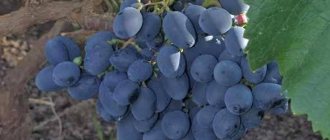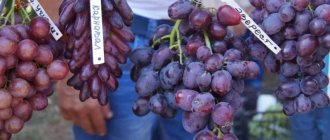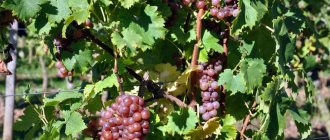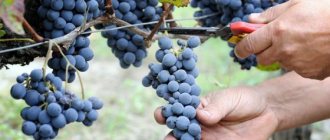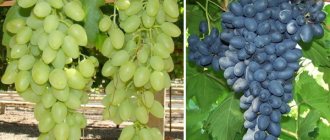Description
The Sofia grape was bred at the end of the last century by amateur gardener V.V. Zagorulko. The varieties Kishmish Radiant and Arcadia were used as parents. The new grapes have absorbed the best qualities of their ancestors. The growing season varies between 110-115 days.
Sofia is a variety of early ripening table varieties. Thanks to its exquisite taste, grapes are gaining popularity among gardeners. We will present a detailed description of the Sofia grape variety, photos, reviews and videos to our readers below.
Bush
The vine of the bush is powerful, bright brown. But the most remarkable thing is the leaves on the grapes. The upper leaves are dark green without pubescence. The leaf blades are large, rounded, slightly dissected, and the edges are wavy. The bush is especially beautiful in autumn, when the foliage turns green-yellow.
That is why grapes are used in landscape design: they decorate gazebos, the porch of a house, and other buildings located on the territory.
Bunches
The variety's clusters are large, weighing more than a kilogram. Sometimes supergiants grow up to three kilograms. The shape of the grape brush is conical. The berries are pressed tightly against each other, so the clusters are never loose.
Attention! The density of the brushes causes some difficulties in care. To prevent the berries from rotting, they must be thinned.
Berries
The berries are slightly elongated, egg-shaped, weighing up to 15 grams. They inherited external characteristics from the Arcadia variety. The size of the berries is 3.3x2 cm. This is clearly visible in the photo.
Berries with juicy and tender pulp, sweet in taste. The aftertaste is nutmeg, bright, and easy to remember. Thin but dense skin with veins is another advantage.
When technically ripe, the berries have a soft pink tint and glow in the sun. Kishmish Sofia grapes are a low seed variety. There are no more than two seeds in the berries. They are soft, like rudiments. Some fruits have no seeds at all.
Flowers
The Sofia variety has only female flowers, so it requires pollinating plants. To prevent cross-pollination, which can lead to loss of varietal qualities, there should be an Arcadia bush on the site nearby.
The grapes bloom for a long time. The pistils of flowers retain moisture for a long time, so all the flowers are pollinated: peas do not form in clusters.
Successful fruiting requires not only pollinating plants, but also proper care, in particular, pruning of bushes. Shoots that bear fruit should be shortened by 4-8 buds.
Productivity
Sofia grapes are a high-yielding variety. It's all about the vigorous bush, on which all the shoots ripen at the same time. Thanks to this, food is supplied in the required quantities. And if grapes are grown in regions with long daylight hours and sufficient sun, then a high and stable harvest is guaranteed.
History of grape growing
The Sofia variety is one of the most popular and successful varieties of Ukrainian grapes. This plant is a product of amateur breeding, the author of which is V.V. Zagorulko. The winegrower has been diligently working for several years to develop a new sustainable variety of so-called green varieties of grapes for temperate climates. As a result, in the early 90s of the twentieth century, he was lucky enough to successfully cross the Kishmish radiant and Arcadia varieties.
Did you know? The most expensive grape in the world is the Japanese variety Roman Ruby. Every year during the harvest period, its fruits are sold at a special auction in the town of Kanazawa; the cost of 1 bunch of 30 berries of the variety can reach up to 11 thousand US dollars.
The resulting hybrid acquired only the best qualities of the parent forms, which made it possible to create not only a highly productive, but also a competitive plant. Today on the market there is a so-called clone of Sofia, the Sidlis grape. This plant was recently bred in the United States; it can be distinguished from the Ukrainian hybrid quite simply. These grapes ripen 15–20 weeks later and also have a richer fruit color.
Distinctive characteristics
Based on the description of the Sofia grape variety, we can name its characteristic features and point out its pros and cons.
Advantages
- Terms of ripening. The grapes are early ripening varieties.
- Taste features. The berries have a delicate, sweet taste with hints of nutmeg.
- Growing conditions. Sofia is a frost-resistant grape that can winter at temperatures down to -21 degrees when grown in the southern regions. In more severe climatic conditions, the vine must be covered.
- Drought. Fruits well in arid climates at high temperatures. If the heat lasts for a long time, the bunches must be covered with grape leaves.
- Survivability. Self-rooted seedlings quickly grasp the soil.
- Marketable condition. The grape bunches are visually attractive and withstand transportation well. That is why the Sophia variety is grown by farmers for sale.
- Application. The berries are good fresh and for processing into juice.
- Excellent immunity. Bushes are not affected by many grape diseases or the symptoms are mild, due to the ability of the vine to fight them. This is oidium, powdery mildew, various types of rot. But to be safe, you need to take preventive measures.
Flaws
Despite the advantages, the variety has disadvantages:
- The presence of only female flowers can lead to cross-pollination with other grape varieties located at a distance of one meter from Sofia.
- The grape variety is susceptible to gray rot.
- Overripe berries may crack.
- The high density of the bunch contributes to the rotting of the berries.
- Overripe berries do not hold well on the bunch and fall off.
Important! Ripe bunches must be removed from the bush in a timely manner, otherwise some of the berries will fall off, and the quality of overripe berries will deteriorate.
The secret of large berries
As gardeners note in reviews, the Sofia variety is not an unpretentious plant. It needs special care, then the berries will be large, and the clusters will not pea. Let us reveal a few secrets to future winegrowers:
- During flowering, it is necessary to artificially pollinate the grapes. To do this, use a powder puff. Thanks to this procedure, the density of the bunch increases.
- You should leave no more than 30 brushes on the bush. More clusters result in smaller berries.
- It is necessary to monitor the number of primordia formed. If there are a lot of them, you need to thin them out. There is no need to spare the ovary, otherwise, due to too much density, some of the berries will begin to rot.
- If some berries in the bunch are lagging behind in development, then during filling they need to be removed so that they do not draw nutrients onto themselves.
- The plant needs to be sprayed against gray rot so that the appearance of the bunch and taste do not deteriorate.
- Large and tasty berries grow with regular feeding.
Reproduction
The Sofia grape is a unique plant because it can be propagated in various ways:
- seeds;
- layering;
- cuttings;
- seedlings;
- through vaccination.
For grafting, a rootstock on which the wood has matured is used. The effect of this method is the presence of an excellent root system. Fruiting begins a whole year earlier.
Important! Tall grape varieties are used as a rootstock so that the plant does not lose this quality in the future.
When propagating by layering, choose the most productive bush with powerful and strong shoots. It is laid horizontally on the surface and sprinkled with fertile soil. To prevent the layer from rising, it is pinned. During rooting, it is necessary to monitor the condition of the soil: drying out is not allowed. When good roots appear on the layering, you can transplant it to a permanent place.
The seed method of growing Sofia grapes takes longer, but the result is always positive.
Landing
The optimal time for planting is spring. It is important to choose the moment when the outside air temperature has finally reached a positive temperature and the possibility of frost is eliminated. It is recommended to plant young, immature seedlings in well-warmed soil.
The heat-loving plant prefers a well-lit place with maximum sunlight. Give preference to the south side of the site. It is better to plant a vineyard on hills or near buildings. “Sofia” is not picky about soils, but does well on fertile loams. If the soil is not particularly fertile, it must be prepared in advance for planting. Humus and sand are added to soils with a high clay content, and sandy soils are covered with clay and organic fertilizers. High acidity is reduced by adding slaked lime.
Pay special attention to soils with high groundwater levels. If it is higher than 1.5 - 2.0 m, take care of arranging a drainage system to remove excess moisture. Otherwise, the root system of the plant may rot.
Vigorous Sofia grape bushes require a large distance from each other. Try to stick to the pattern, leaving about 3 m between the bushes, and up to 4 m between the rows. This space will be enough for the free development of the vineyard and for easy plant care.
Dig holes about 80 cm deep. Install a bottom layer of crushed stone, then cover with organic fertilizers mixed in equal proportions with sand and soil. Near the center of the hole, install a support for gartering the vine. Allow the soil to settle for several weeks.
Select seedlings for planting with healthy white roots. Soak them for 1-2 days in water or solution to stimulate growth. Then place it in the center of the hole, carefully straightening the roots. Fill with the remaining soil so that the upper part of the seedling with fertile buds remains above the surface of the ground.
Water generously with 1 - 1.5 buckets of water and mulch the soil around each bush with a three-centimeter layer of onion peels or grass clippings.
Features of care
As follows from the description and characteristics of the variety, any gardener can grow it. Care is almost identical to other varieties of grapes. But you need to take into account some features:
- Sofia reacts negatively to large amounts of nitrogen-containing drugs. But phosphorus-potassium fertilizers allow the bush to develop well, bear fruit in a timely manner and produce a rich harvest.
- When growing grapes in regions where temperatures drop below -21 degrees, you need to think about proper shelter for the winter.
- During prolonged heat, the bunches can be damaged, so they are covered with grape leaves.
- Proper formation of the bush contributes to obtaining stable yields. The vine needs to be pruned every year. No more than eight eyes are left on the bush. Overloading reduces the weight of the bunches.
- Sofia grapes need to be watered abundantly before, during flowering and during the period of berry filling. When the berries begin to ripen, you need to be careful with watering. A large amount of water leads to cracking of the berries.
Diseases and pests
The description states that Sofia grapes are resistant to many diseases and pests. But you still need to make every effort to get a rich harvest of large berries with a delicate taste.
The most dangerous pests for grape plantings are wasps and birds, who love to feast on sweet berries. Damaged fruits begin to rot, which deteriorates the presentation. You can escape from birds with the help of nets that are thrown over the bushes or by hiding each bunch in plastic bags.
As for wasps, they cause a lot of problems. First, you need to survey the area in search of wasp nests. Found insect colonies are burned. Secondly, it is advisable to hang Velcro baits on the bushes.
There is no point in relying on disease resistance if different grape varieties grow on the site. In any case, preventive treatments will be required using Bordeaux mixture, karbofos, vitriol, and other special preparations.
When is the best time to plant this grape variety?
It should be noted that planting grape crops can be done from spring to late autumn. Planting time directly depends on which planting method you choose.
In the spring, seedlings are planted. They can be grown from cuttings or simply left over from the fall. The first planting can be done as early as March, when relatively warm air temperatures have established. And in order for the seedling not to freeze, it should be covered. This can be done using a regular cardboard box with a small hole for the top. It will be possible to remove it in early May
If we talk about seedlings that were grown from cuttings, then they should be planted in the first half of June
It is very important that the seedling grows well in the glass, so that later it will be convenient to replant it along with the soil from the glass
Spring planting has its advantages:
- A bush that was planted in the spring manages to adapt well and take root. A well-developed root system is capable of independently feeding the bush.
- Seedlings that were planted in the spring begin to bear fruit much faster.

